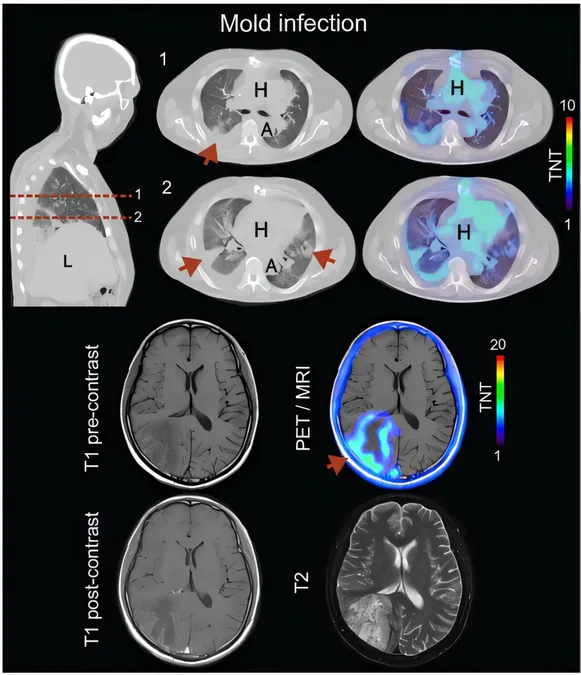
Revolutionary PET Tracer Could Transform Mold Infection Diagnosis in At-Risk Patients!
2025-06-24
Author: Mei
A Breakthrough in Diagnosing Life-Threatening Mold Infections
A groundbreaking PET radiotracer, known as 18F-FDS, is shaking up the medical field by promising to detect a diverse array of mold infections that can prove fatal, especially for vulnerable populations like cancer and transplant patients. This exciting revelation was unveiled at the Society of Nuclear Medicine and Molecular Imaging 2025 Annual Meeting, and is set to be published in the prestigious Journal of Nuclear Medicine.
Why This Discovery Matters—High Stakes in Mold Infections
Advancements in cancer and immunosuppressive therapies have been lifesaving, extending the lives of many patients. However, this progress comes with a significant downside: a growing number of individuals now have weakened immune systems, making them susceptible to invasive mold infections. Alarmingly, these infections can lead to mortality rates as high as 85%. Timely and precise diagnosis is critical to enhance patient survival chances.
The Challenge of Detection—Breaking New Ground
According to Dr. Carlos Ruiz-Gonzalez, a dedicated postdoctoral researcher at Johns Hopkins University, detecting these invasive infections has been a daunting task. Traditional methods often involve invasive procedures or rely on inadequate biomarkers that can't always identify the various mold species. The aim of this study was clear: create a PET tracer that could detect a wide spectrum of mold infections and differentiate them from inflammation with high accuracy.
Innovative Testing—Proving the Efficacy of 18F-FDS
The 18F-FDS tracer was rigorously tested in laboratory settings to assess its capability to identify 30 different strains of pathogenic molds. Subsequently, researchers conducted 18F-FDS PET/CT scans on mice with compromised immune systems as well as four human patients already diagnosed with invasive mold infections and five control patients suffering from inflammatory diseases without any infections.
A Promising Outcome—Rapid and Specific Detection
Impressively, the 18F-FDS radiotracer demonstrated the ability to rapidly and specifically target a variety of harmful mold species—including several drug-resistant strains—while completely bypassing heat-killed molds and healthy human cells. In mouse studies, it effectively pinpointed infections in critical areas like the lungs, brain, and sinuses, convincingly distinguishing between infectious and non-infectious conditions.
Real-World Impact—The Future is Bright for Patient Diagnosis
In the clinical setting, 18F-FDS PET scans safely identified and localized mold infections—successfully uncovering one case that had evaded detection in a prior brain MRI. Dr. Ruiz-Gonzalez highlighted the significance of this advancement: "This research showcases the potential of 18F-FDS PET as a noninvasive, reliable diagnostic tool for mold-related diseases, which could change countless lives globally. Plus, the tracer can be easily synthesized from readily available materials, making it accessible to patients worldwide."
Conclusion—A Game Changer in Medical Imaging!
As medical professionals navigate the complexities of mold infections in immunocompromised patients, the 18F-FDS PET tracer emerges as a beacon of hope. With its promise of accurate, timely detection, this innovation is poised to revolutionize patient care and outcomes in the fight against invasive mold infections.



 Brasil (PT)
Brasil (PT)
 Canada (EN)
Canada (EN)
 Chile (ES)
Chile (ES)
 Česko (CS)
Česko (CS)
 대한민국 (KO)
대한민국 (KO)
 España (ES)
España (ES)
 France (FR)
France (FR)
 Hong Kong (EN)
Hong Kong (EN)
 Italia (IT)
Italia (IT)
 日本 (JA)
日本 (JA)
 Magyarország (HU)
Magyarország (HU)
 Norge (NO)
Norge (NO)
 Polska (PL)
Polska (PL)
 Schweiz (DE)
Schweiz (DE)
 Singapore (EN)
Singapore (EN)
 Sverige (SV)
Sverige (SV)
 Suomi (FI)
Suomi (FI)
 Türkiye (TR)
Türkiye (TR)
 الإمارات العربية المتحدة (AR)
الإمارات العربية المتحدة (AR)